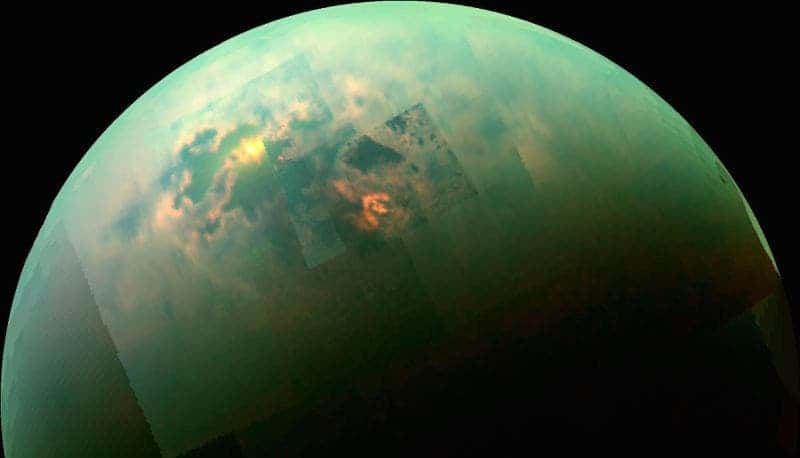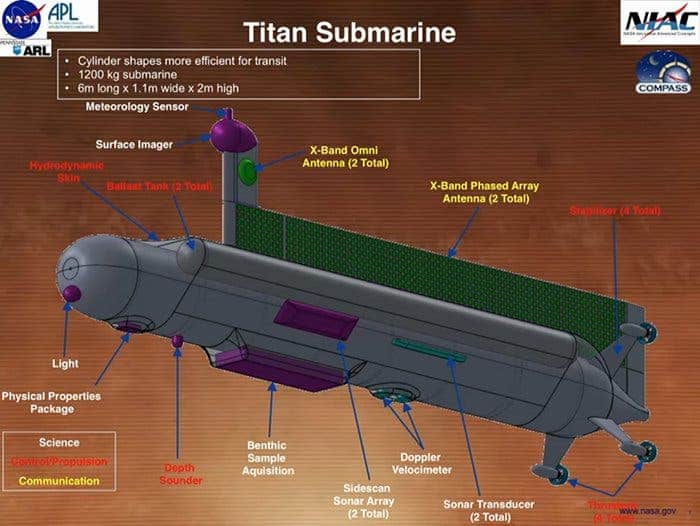NASA is hard at work trying to get a robot on Titan. To find out exactly what it would be up against, the agency has built a tiny, freezing methane ocean at the Washington State University.

Image credits NASA / JPL.
Titan is the second largest moon in our solar system, only more modest in size than Jupiter’s Ganymede. However, it’s a spot that NASA has been itching to visit for quite some time now, as it is the largest body after Earth to harbor stable, liquid oceans. But put the snorkel away, because this is by no means an ocean you’d want to take a dip in. Titan isn’t covered in water, it’s covered in methane — frigid, liquid methane.
To coldly go where nobody has gone before
NASA plans to send an autonomous submarine to poke around Titan’s seas and oceans some time in the next 20 years. So far, they’ve been designing the mission and the craft based on data beamed back by the Cassini mission. However, environmental conditions on the moon are so dramatically different and extreme compared to those we’re used to, that the agency believes we need more experimental data to check the bot against.
As such, they’ve teamed up with scientists at Washington State University to recreate the moon’s methane ocean in a laboratory.
The WSU researchers built a test chamber filled with a “liquid mixture at very cold temperatures to simulate the seas of Titan,” a press release from the University details. “They added a two-inch, cylinder-shaped cartridge heater that would approximate the heat that a submarine would create”. The project was led by Ian Richardson, a former WSU graduate who interned at NASA on an unrelated research project.
“My research just took a right turn, and I went with it. It’s a crazy experiment, and I never thought I would have had this opportunity. It’s been a very fun and challenging experimental design problem,” he said.
The make-believe ocean has revealed two hurdles that researchers will have to overcome when designing the sub-to-be: the formation of gas bubbles and recording video at the freezing temperatures.

Image credits NASA.
If the submarine is powered by a heat-generating mechanism, it would cause nitrogen bubbles to form in the very cold liquid on Titan (which is mostly made up of a methane-ethane mix at roughly -185° Celsius (-300° Fahrenheit). These bubbles have shown that they can severely hinder the submarine’s mobility and make it difficult for onboard sensors to collect data.
Even if such bubbles fail to materialize, snapping images and videos of the sub’s surroundings will be a challenging task — mostly because it’s a really cold, pressurized environment (comparable to being under 30 meters/100 feet of water).
One piece of good news is that the nitrogen fraction in the mix lowers the freezing point of Titan’s oceans from about -185° to roughly -200° Celsius (-297° to -324° Fahrenheit).
“That’s a big deal. That means you don’t have to worry about icebergs,’’ Richardson explains.
The team says they worked around the temperature and pressure problems and developed a device that allowed them to shoot video footage in the liquid and snow methane-ethane mix inside the chamber. In the future, all measurements and data recorded in this experiment will be used to ” to aid in thermodynamic modeling of the Titan seas as well as the design of the Titan Submarine,” he added.
The paper “Experimental PρT-x measurements of liquid methane-ethane-nitrogen mixtures.” has been published in the journal Fluid Phase Equilibria.


